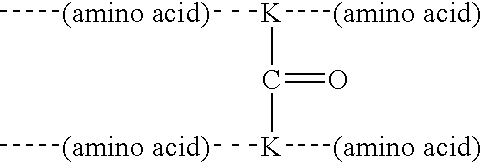Peptides and compounds that bind to the IL-5 receptor
a technology of il-5 receptor and peptide, which is applied in the field of peptides and compounds, can solve the problems that conventional methods and therapeutic agents may not be completely effective in the treatment of asthma or other immunomediated inflammatory diseases in all patient populations, and achieve the effect of inhibiting the production and accumulation of eosinophils and preventing alpha chain participation
- Summary
- Abstract
- Description
- Claims
- Application Information
AI Technical Summary
Benefits of technology
Problems solved by technology
Method used
Image
Examples
example 1
[0224]Various peptides of the invention were synthesized using the Merrifield solid phase synthesis techniques (see Steward and Young, Solid Phase Peptide Synthesis, 2d. edition (Pierce Chemical, Rockford, Ill. (1984) and Merrifield (1963) J. Am. Chem. Soc. 85:2149) on an Applied Biosystems Inc. Model 431A or 433A peptide synthesizer. Alternatively, a Milligen / Biosearch 9600 automated instrument could be used.
[0225]The peptides were assembled using standard protocols of the Applied Biosystems Inc. (ABI) System Software version 1.01. Each coupling was performed for one-two hours with HBTU and HOBt. Double-couplings were performed at each step.
[0226]The resin used was HMP resin or PAL resin (Milligen / Biosearch), which is a cross-linked polystyrene resin with 5-(4′-Fmoc-aminomethyl-3,5′-dimethyoxyphenoxy)valeric acid as a linker. Use of PAL resin results in a carboxyl terminal amide functionality upon cleavage of the peptide from the resin. Upon cleavage, t...
example 2
Dimer Synthesis: Regioselective Cysteine Pairing
[0230]This technique calls for the use of two different Cys protecting groups. The first disulfide bond is formed by selectively removing the first set of protecting groups. The second disulfide bond is formed by removing the second set of protecting groups from the peptide as shown schematically below.
[0231]
Regioselective Cysteine Pairing-Peptides Containing Tryptophan:
[0232]As shown below, Acm was used as the protecting group for the first Cys and Trt was used for the second and third Cys residues. The procedure of Tamamura et al., Chem. Commun. 151 (1998) was used to effect the dimerization. The linear purified peptide (with 1 —S—S— and 1-Acm) (80 mg, 0.043 millimole) and silver trifluoromethanesulfonate (1.09 gm, 100 equiv.) is dissolved in TFA-anisole mixture (160 ml at 20:1 v / v) to give a concentration of 2 mg of peptide in 1 ml of TFA-anisole.
[0233]The reaction mixture is stirred for three hours at room temperature and filtered ...
example 3
Dimer Synthesis: Oxidative Folding of Cysteine
[0238]This technique is described further in Morder et al., Biopolymers (Peptide Science) 40:207–234 (1996). Unlike the regioselective cysteine pairing method, only one type of protecting group for the cysteine was used. The linear peptide with 3 —SH has been oxidized to form a dimer directly as described below.
[0239]The linear peptide with 3 —SH is oxidized in Tris buffer, pH 7.8 for two days. The course of the reaction is monitored by HPLC. The product can be purified by RP-HPLC. After lyophilization, the stereochemistry is confirmed by strong cation exchange column chromatography and by mass spectrum. The disulfide bond pattern can be checked by tryptic digest.
[0240]
PUM
| Property | Measurement | Unit |
|---|---|---|
| molecular weight | aaaaa | aaaaa |
| molecular weight | aaaaa | aaaaa |
| molecular weight | aaaaa | aaaaa |
Abstract
Description
Claims
Application Information
 Login to View More
Login to View More - R&D
- Intellectual Property
- Life Sciences
- Materials
- Tech Scout
- Unparalleled Data Quality
- Higher Quality Content
- 60% Fewer Hallucinations
Browse by: Latest US Patents, China's latest patents, Technical Efficacy Thesaurus, Application Domain, Technology Topic, Popular Technical Reports.
© 2025 PatSnap. All rights reserved.Legal|Privacy policy|Modern Slavery Act Transparency Statement|Sitemap|About US| Contact US: help@patsnap.com



